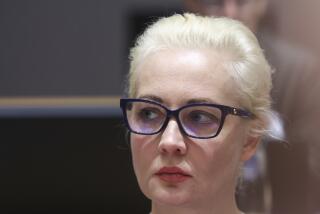The Reluctant First Lady : Profile: Naina Yeltsin is no Raisa Gorbachev. But she is giving the Russian people what they expect--a political wife who is traditional, anonymous and colorless.
- Share via
WASHINGTON — It would be hard to imagine Raisa Gorbachev referring to herself as a babushka the way Naina Yeltsin recently did. Perhaps Madame Gorbachev would describe herself as an intellect or a model of Marxism, modernism and fashion. But she most certainly would stiffen at the suggestion she was a formless grandmother in sensible shoes.
But if Raisa’s bold style and Western wardrobe were a break with tradition, then Naina Yeltsin’s hausfrau look and shy manner are something of a throwback. And if there were parallels between Raisa and Nancy (Reagan)--both of whom injected themselves into their husbands’ political careers--then Naina probably has more in common with Barbara “America’s First Grandmother” Bush.
After four decades enduring her husband Boris’s obsession with work and politics, Naina Yeltsin, 60, is now reluctantly playing First Lady to his Russian president the way their people like and expect: She is traditional; she is anonymous; she is colorless.
When the Yeltsins arrive in Washington today for the first summit with President Bush since Mikhail Gorbachev resigned last winter, don’t expect Naina to bound off the plane with her gold card burning through her pocketbook and start bantering with the Bushes the way Raisa might have. Rather, she is likely to stand silently demure a few feet behind her husband, according to a Moscow spokesman for the Russian president.
While Bush and Yeltsin address security and economic issues, their wives will visit a downtown Washington soup kitchen, and lunch at Mt. Vernon. There will be two state dinners and sightseeing, but no shopping sprees. And Naina Yeltsin is not likely to respond the way Raisa Gorbachev did to questions from foreign reporters.
“Mrs. Yeltsin does what she’s supposed to do and no more,” said the spokesman, who asked to not be identified. “She’s not like Mrs. Gorbachev. She’s unassuming.”
In a new Yeltsin biography, authors Elena Klepikova and Vladimir Solovyov include an amusing chart comparing Boris Yeltsin to Mikhail Gorbachev. Under “type of wife” for Gorbachev it says, “Bossy, powerful, abrupt, dominating, resembles his mother”; for Yeltsin it says, “Motherly, conceding, caring, patient, resembles his mother.”
Yet, Naina Yeltsin isn’t quite the cliched relic one might expect.
She worked 29 years as a shift engineer at the Institute of Waterways in their hometown of Sverdlosk, an industrial center in the Ural Mountains now called Yekaterinburg.
When Gorbachev called Yeltsin to Moscow in 1985, he insisted that his wife stop working to help the family adjust to life in a new city. The move into a three-bedroom apartment apparently was a strain for her, their two daughters, Lena and Tanya, and three grandchildren. Naina Yeltsin had made it to chief engineer in Sverdlosk and was two years from retirement; in addition, she had a close family and support network there. After the move to Moscow she had to cook and shop for three families and care for small children.
“This was very hard for her because for her it is very important to be independent,” Klepikova said in a recent interview. “She is not narrow-minded but she is also not a public person. She is an intensely private woman.”
That characteristic is not unusual for most First Ladies of the former Soviet Union, whether by their nature or on demand of their husbands, according to Blair Ruble, director of the Kennan Institute of Advanced Russian Studies in Washington.
In most cases, he says, the leadership simply didn’t want their private lives publicized: “A lot of the Soviet elite intermarried, so there were family ties that ran throughout the political system and this network was best left unrevealed.”
In other cases, Soviet leaders came from peasant or working-class families in which women were not educated and were excluded from political life.
Thus, Raisa Gorbachev’s widely publicized shopping binges were all the more scandalous considering many Soviets--as well as the CIA--apparently were unaware her husband’s predecessor, Yuri Andropov, had a wife. Until she turned up at Andropov’s 1984 funeral.
Ultimately, the concept of a wife with a private-public influence is “a peculiar American obsession,” according to Ruble and others. Can anyone name the wives of Canadian Prime Minister Brian Mulroney, German Chancellor Helmut Kohl or Japanese Premier Kiichi Miyazawa?
Raisa Gorbachev had such stature, but in the end it hurt her husband politically.
“Her image was a big negative,” says an official in the Russian embassy in Washington, asking to remain anonymous. “That Mrs. Yeltsin is a homely housewife, this is much better. When you come back home after crazy day do you want someone to confront or comfort you? Obviously you want comfort.”
In 1987, Yeltsin pointedly criticized Raisa Gorbachev’s prominence. And later, after his ascendancy, he made it clear to ABC’s Barbara Walters during a Moscow interview that he would not put up with such a wife.
“Mr. Gorbachev once said in an interview that he discusses everything with Mrs. Gorbachev,” Walters said. “Do you discuss your decisions with Mrs. Yeltsin?”
“No,” Yeltsin replied.
“Well, that took care of that.” Walters added.
“Well, in our family, I’m the boss,” he said.
Some of Yeltsin’s friends say he is also the household’s child.
“Boris was a younger son (for Naina),” a former classmate told authors Klepikova and Solovyov. “She took complete care of him, thoroughly sheltering him from reality.”
Yeltsin had little to do with raising his daughters, according to the new biography. The book also quotes a close friend from Sverdlovsk saying that home and family were never a priority for Yeltsin: “Within the family he felt a kind of emotional claustrophobia; it seemed to curb his public temperament, which drove him to the Great Outdoors of public service, and, later to politics. As a family man, Yeltsin is a disaster.”
The Yeltsins met while both studied at the Ural Polytechnical Institute. According to friends, Yeltsin had been preoccupied with a large group of friends and it took a long time before he singled out one girl, Naya Girin. (Her proper name is Anastasia but friends called her Naya or Naina.) Yeltsin thought her birth name was more beautiful and refused to address her by the shorter name even after they married.
Though Yeltsin saw special qualities in Naina as early as their sophomore year, they waited many years before marrying. After college there “were years of uncertainty,” according to the Klepikova-Solovyov biography. While they were assigned jobs in different cities 440 miles apart, the authors write that Yeltsin “was not upset.
“He was too busy mastering 12 building trades in one year. He was happy where he lived: in the dorm, surrounded by people. He felt none of the anxiety one would expect from a separated lover; it never occurred to him that he could lose Naya forever. Yet it was not a case of indifference. Once again his public interest took priority over personal ones.”
In a recent interview with the Dutch magazine Vrig Nederland, Naina Yeltsin confirmed that not much has changed since their college days:
“Our whole family life turns around Boris Nikolayevich. We want to make his life as easy and as nice as possible.”
More to Read
Sign up for Essential California
The most important California stories and recommendations in your inbox every morning.
You may occasionally receive promotional content from the Los Angeles Times.













